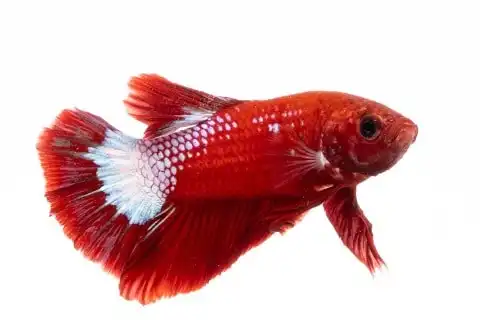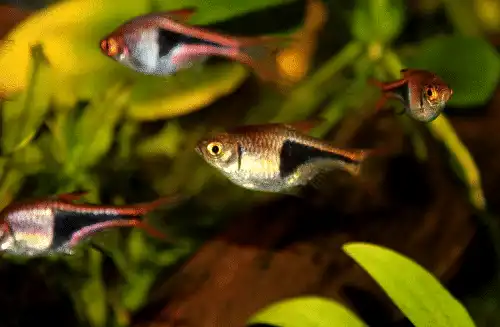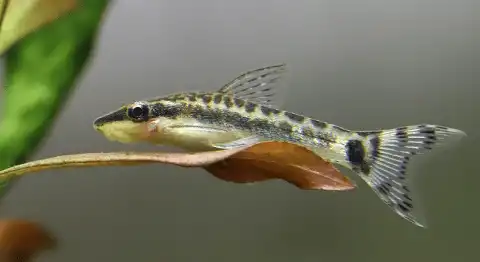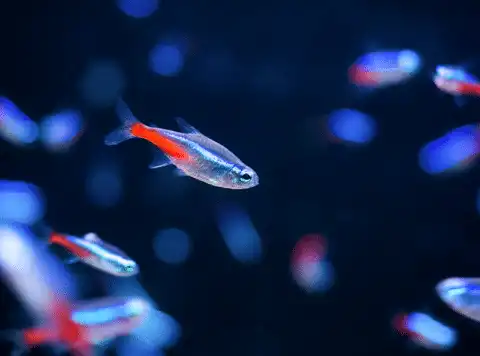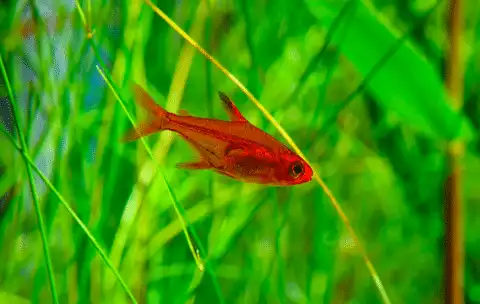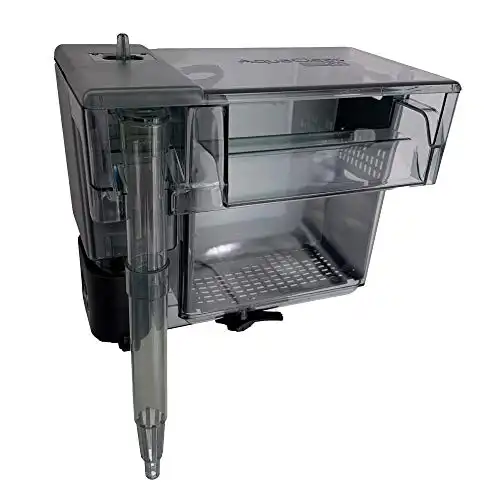Thank you for visiting! By the way… any links on this page that lead to products on Amazon and other stores/partners are affiliate links Aquarium Store Depot earns a commission if you make a purchase.
Are you looking for some great fish to keep with your platies? Well, I’ve got some good news for you. There are stacks of great platy tank mates out there, and in this post, we’ll be covering the 15 best!
We’ll also cover the most important tips you need to know about setting up a great aquarium for your platy community, so read along to the end for that. So let’s get started!
Key Takeaways
- Platies are wonderful community fish with many potential tank mates
- Choose non-aggressive fish that are not big enough to eat your platies
- Fish species that come from similar natural habitats are ideal because they share the same tank requirements
- Many community fish need to be kept in schools, so make sure you have enough room in your tank
Caring For Your Platies- A Brief Recap
Before you can start choosing the perfect platy fish tank mates, it’s really important to know what they need to stay healthy. So let’s start out with a quick recap on how to care for this species.
Types of Platies
There are two species of platy fish in the fish-keeping hobby, the Southern Platy (Xiphophorus maculatus) and the variable platy (X. variatus). Selective breeding has resulted in a huge variety of different breeds, including the following:
- Variegated platy
- Mickey mouse platy
- Swordtail platy
- High fin platy
- Wagtail platy
- Balloon platy

The good news is that all these fish have pretty much the same care requirements, so if you stick to the following guidelines, they should do great.
Aquarium Size & Parameters
Platy fish come from the warm waters of Mexico, Central America, and South America. These tropical fish are most at home in water temperatures of about 68 to 79 °F, so most people will need an aquarium heater to mimic their natural habitat.
These fish are pretty adaptable when it comes to water parameters, but they will do best in the following conditions:
- pH: 7 – 8.2
- Water hardness: 10-30 dGH
- Minimum Tank Size: 15 gallons
Platies are a great choice for smaller tanks, with 15 gallons being the minimum size required. If you wish to keep them with other species, a 30-gallon or larger tank would be more suitable.
Aqueon's 20 gallon aquarium kit offers all the basics to start off on the right foot.
Maintenance
Of course, it goes without saying that Platy fish need good water quality. That means their tank needs a good quality aquarium filter and regular maintenance, including partial water changes.
If you haven’t already got one, spend a few dollars and get yourself a water test kit to monitor the water quality and parameters in your tank.
Breeding Platies
If you’ve been keeping platy fish for a while, you probably already know how easy these fish are to breed. Of course, platy fry are vulnerable to being eaten by most freshwater fish, and even their own species.
If you want to breed these fish, I’d recommend setting up a separate breeding tank. Female platies produce live, free-swimming fry, so moving the pregnant platy to a safe tank to give birth and allowing the small fish to grow safely is your best bet.
Feeding
Platy fish have a varied diet, and they are very easy to feed. Fortunately, most of the platy fish tank mates in this article will thrive on the same foods, but I’ll give you a heads-up wherever each species needs a specialized diet.
Feed your platy fish once or twice a day, and only as much as they can eat in a few minutes. A high-quality flake or micro-pellet food will work great as a daily staple, but add a small helping of live or frozen foods every few days to supplement their diet.
Top 15 Tank Mates for Platy Fish
The secret to a successful community aquarium is making sure all your fish are happy in the same environment and that they don’t fight or harass each other. We have a wonderful video just for you from our YouTube Channel. Subscribe if you enjoy the video and following along with our blog post.
Each of the recommended platy fish tank mates in this post is an excellent option, but it’s still really important to ensure that your tank setup and parameters overlap with the tank requirements of each species. Take note of the following stats to help you choose your next fish:
- Size
- Tank size
- Scientific name
- Origin
- Swimming level
- pH
- Water temperature
- School size
Now that we’ve run over the basic concepts to remember when choosing companion fish, it’s time to move on to some recommended species. Are you ready to learn about 15 awesome platy fish tank mates for your platy fish? Then let’s dive right in!
1. Molly Fish
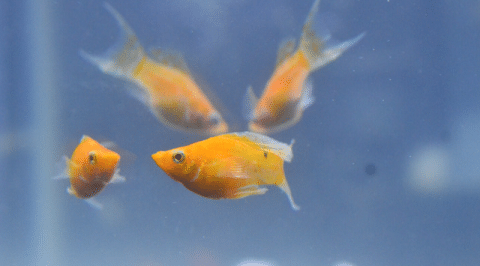
- Size: 3-5 inches
- Tank size: 30 gallons
- Scientific name: Poecilia latpinna & P. sphenops
- Origin: North & South America
- Swimming level: Middle and upper levels
- pH: 7 – 8.5
- Water temperature: 70 – 79°F
- School size: 3+
Mollies and platies have a lot in common, and that makes them great tank mates. Like the platy, mollies come in a wide variety of color variations, and both are live-bearing fish.
Mollies are larger fish, that can reach 5 inches in length, so you’ll need a tank of at least 30 gallons to keep these hardy fish.
2. Guppy Fish
An undemanding fish that is a livebearer. Many varieties available
- Size: 1.5 – 2.5 inches
- Tank size: 10 gallons
- Scientific name: Poecilia reticulata
- Origin: South America & Caribbean
- Swimming level: All levels
- pH: 7 – 8.5
- Water temperature: 64 – 82°F
- School size: 3+
Guppy fish are yet another live-bearing fish, just like mollies and platies. Guppies differ in being smaller and slimmer, but even more colorful. These peaceful fish prefer neutral to slightly alkaline water, so keep that in mind when considering them for your community tank.
There are many different breeds of guppies, but males are always the smaller and more colorful sex. Guppy fish are prolific breeders, but their fry usually get eaten by the other fish in the tank.
3. Honey Gourami
One of the more peaceful Gourami fish available in the hobby. Has a unique yellow coloration and only grows up to 2 inches in length
- Size: 2 inches
- Tank size: 10 gallons
- Scientific name: Trichogaster chuna
- Origin: India
- Swimming level: Middle and upper levels
- pH: 6 – 8
- Water temperature: 74 – 82°F
- School size: 1+
The honey gourami is a beautiful little freshwater fish that can thrive in the same tank conditions as the platyfish. These interesting relatives of the betta fish can be kept as a single specimen or in a pair.
4. Betta Fish
Use Coupon Code ASDFISH at Checkout
Betta Fish are one of the most beautiful varieties of freshwater fish available in the hobby. Easy to care for with plenty of varieties!
- Size: 2.5 inches
- Tank size: 5 gallons
- Scientific name: Betta splendens
- Origin: Thailand
- Swimming level: Middle & upper levels
- pH: 6 – 8
- Water temperature: 72 – 86°F
- School size: 1
Betta fish are hugely popular for their amazing looks and the fact that they can be kept in just 5 gallons or more. They are aggressive fish that are usually kept alone, but they can thrive in a community setup if they are the only betta in the tank.
If you do go this route, try choosing a betta fish that is a different color from your platies, and avoid introducing bettas if you have platy fish with long fins. The idea is to ensure your betta doesn’t think the platies are other bettas!
Add just one female or male fish and provide plenty of hiding spaces and a large tank to avoid aggression in a cramped environment.
5. Zebra Danio

- Size: 2 inches
- Tank size: 20 gallons
- Scientific name: Brachydanio rerio
- Origin: India
- Swimming level: All levels
- pH: 6 – 8
- Water temperature: 64 – 75 °F
- School size: 6
The zebra danio is an awesome community fish, and they get along great with platies! Keep these hardy fish in a school of at least 6 individuals (more is better) to enjoy their natural behaviors.
Zebra Danios are very fast and active fish so add them to a community tank of at least 20 gallons or larger.
6. Cory Catfish

- Size: 1 – 3 inches
- Tank size: 20 – 30 gallons
- Scientific name: Corydoras spp.
- Origin: South America
- Swimming level: Bottom
- pH: 7 – 8
- Water temperature: 74 – 80°F
- School size: 4+
Including a few bottom-dwellers in your platy community tank can add a whole new level of activity and interest. The corydoras catfish is an ideal choice and an amazing platy fish tank mate.
Cory catfish are small, peaceful fish that hang out in schools at the bottom of the tank. There are loads of different species, including spotted, speckled, and striped options.
Their care requirements are pretty similar, but check out each species’ needs and be sure to buy small groups of at least four specimens to enjoy their entertaining social behavior.
7. Bristlenose Plecos
The Bristlenose Pleco is a smaller Pleco that does a great job of eating algae. Peaceful and gets along with most fish
- Size: 5 – 6 inches
- Tank size: 20 – 30 gallons
- Scientific name: Ancistrus sp.
- Origin: Amazon River Basin, South America
- Swimming level: Bottom
- pH: 5.5 – 7.5
- Water temperature: 73 – 80 °F
- School size: 1
The bristlenose pleco is probably the strangest species on this list, but a great choice if you want a small bottom-dweller that can help control algae in your tank.
These fish are generally peaceful, but they can fight amongst themselves if you keep more than one. Bristlenose plecos also need plenty of driftwood to graze on and hiding places to stay happy and healthy.
8. Harlequin Rasboras
A peaceful schooling fish. An ideal community fish. A great beginner fish
- Size: 1.75 inches
- Tank size: 15 gallons
- Scientific name: Trigonostigma heteromorpha
- Origin: Southeast Asia
- Swimming level: Upper & middle
- pH: 5 – 7.5
- Water temperature: 70 – 82°F
- School size: 8+
There are many amazing rasbora species in the aquarium hobby, but one stands out as a firm favorite for community tanks. The harlequin rasbora is a beautiful schooling fish with an interesting black triangular marking on its side.
These Harlequins are very easy to care for, and they get along perfectly with platies. Rasboras are very social fish, so keep them in small groups to enjoy all they have to offer.
The other species of rasboras can work too, but avoid very small fish like chili rasboras as they may be intimidated or even eaten by their larger tank mates.
9. Otocinclus
A small algae-eating fish. Also great with freshwater shrimp.
- Size: 1.75 inches
- Tank size: 10 gallons
- Scientific name: Otocinclus sp.
- Origin: South America
- Swimming level: Bottom
- pH: 6 – 7.5
- Water temperature: 74 – 79°F
- School size: 4+
Platy fish do eat algae, but they are not always able to keep their tank completely clean. The amazing little otocinclus catfish is an ideal choice for algae control in your community tank, and these little fish are really fascinating to watch.
Otos rely on a steady algae supply to stay healthy, so avoid adding them to a new aquarium without a good food source. They are completely vegetarian, so this is one species that you can safely keep with platy fry.
10. Boeseman’s Rainbowfish

- Size: 4 inches
- Tank size: 30 gallons
- Scientific name: Melanotaenia boesemani
- Origin: Papua New Guinea
- Swimming level: Upper & middle levels
- pH: 7 -8
- Water temperature: 72 – 77°F
- School size: 6+
Boeseman’s rainbow fish is a medium-sized species that makes quite a statement in any aquarium. These fish have neon blue shades on the front half of their body and vivid yellow-orange on the back, creating a striking two-tone appearance.
These rainbowfish are most happy when kept in a group of their own kind. You’ll want at least 6 of them in the same tank, so consider this species only if you can provide 30 gallons or more space.
The Boeseman’s rainbow fish is just one of many awesome species in this family. Check out my guide to 15 popular types of rainbowfish to learn about the other great species you can keep!
11. White Cloud Mountain Minnows
A very peaceful fish that does well in coldwater fish. Other minnow varieties are also available
- Size: 1.5 inches
- Tank size: 15 gallons
- Scientific name: Tanichthys albonubes
- Origin: China
- Swimming level: Top & middle
- pH: 6 – 8.5
- Water temperature: 57 – 71°F
- School size: 6+
White cloud mountain minnows are graceful and peaceful freshwater fish that you can keep with platy fish in a community tank. These small fish thrive in tanks as small as 15 gallons, and they come in some cool varieties like the long-tailed and golden options.
One important thing to note is that the white cloud minnow’s natural habitat is cold water streams, which means they can only co-habit with platies in water temperatures of 68 to 71°F.
12. Neon Tetra
Use Promo Code ASDFLIPPROMO
One of the most popular freshwater community schooling fish available in the aquarium trade. Great neon blue colors!
- Size: 1 inch
- Tank size: 15 gallons
- Scientific name: Paracheirodon innesi
- Origin: South America
- Swimming level: Middle
- pH: 4 – 7.5
- Water temperature: 70 – 77°F
- School size: 6+
There’s a reason why neon tetras are one of the most common aquarium fish in the hobby. These brightly colored schooling fish are super peaceful, and they make an excellent platy fish tank mate.
Neon tetras thrive in well-maintained community aquariums, just make sure you keep them in a group of 6 or more- these fish are social!
13. Ember Tetra
A small red tetra that grows up to 1.25 inches. A very peaceful schooling fish
- Size: 0.75 inches
- Tank size: 10 gallons
- Scientific name: Hyphessobrycon amandae
- Origin: South America
- Swimming level: Middle
- pH: 5 – 7
- Water temperature: 68 – 82 °F
- School size: 6
The ember tetra is yet another awesome tropical fish from the tetra family. These colorful schooling fish are tiny, so they are a good tank platy fish tank mate choice if you don’t have a lot of room to play with them.
Ember tetras are bright orange, so they will complement colorful platy breeds like the sunset variatus platy in a well-planted community aquarium.
14. Angelfish
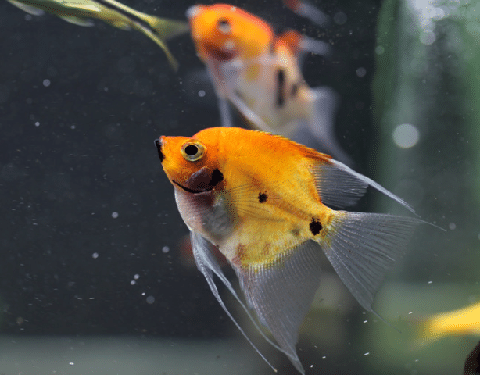
- Size: 6 inches
- Tank size: 29 gallons
- Scientific name: Pterophyllum scalare
- Origin: South America
- Swimming level: Middle
- pH: 6 – 7.4
- Water temperature: 76 – 86°F
- School size: 1+
The Angelfish is an unmistakable favorite in the aquarium industry and an ideal centerpiece fish for your tropical freshwater tank. These fish have really long anal and dorsal fins that make them taller than they are long!
Angels may be on the larger side, but these stunning South American cichlids can make great companion fish for your platies. However, adult angel fish are large enough to swallow small fish, so make sure your platies are fully grown.
15. Hatchetfish
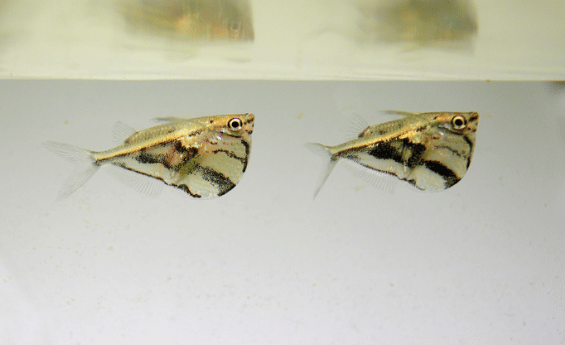
- Size: 1.25 inches
- Tank size: 20 gallons
- Scientific name: Carnegiella strigata
- Origin: South America
- Swimming level: Top
- pH: 5.5 – 7.5
- Water temperature: 75 – 81°F
- School size: 6+
Hatchetfish are an exceptional addition to any tropical aquarium. These surface-dwelling fish are deep-bodied and grow to just over an inch long but can jump out of your tank. It’s important to securely cover your tank to prevent them from escaping. Because they are sensitive to water quality, they’re best kept by experienced aquarium hobbyists. Keeping a school of at least 6 of their own kind and maintaining great water quality is key to keeping them healthy and happy.
These schooling fish can be a little on the sensitive side, so they are better suited to more experienced aquarium hobbyists. Keep a nice school of at least 6 of their own kind and maintain great water quality to keep these fascinating fish in great shape.
Community Aquarium Setup Guidelines
Have you found the perfect platy fish tank mates? Before you order your new pets, take a minute to run through this quick community tank setup checklist.
The Aquarium
You will need a cycled aquarium of at least 30 gallons. However, a 20-gallon could work if you’re keeping just two or three small species. Make sure your tank has a secure hood- most fish are great jumpers!
Essential Hardware
Purchase a good quality aquarium filter. Hang-on-back and internal power filters are great budget choices for small and medium community tanks, but consider a canister filter if you want to keep your aquarium clutter-free.
The Best Aquarium Power Filter
The worlds best selling and most reliable power filter on the market. Unchanged for years because it's so reliable and versatile
You’ll also need a reliable aquarium heater. Almost all the species on this list are tropical fish that need water temperatures around the mid-70s (Fahrenheit).
Substrate & Decorations
Add a layer of an aquarium-safe substrate like sand or gravel to the bottom of your tank. Choose a smooth substrate if you plan on keeping small bottom-dwellers like cory catfish.
Add a few decorations too, but make sure they are designed for fish tanks. You can use natural materials like driftwood and rocks, or use artificial cave ornaments.
Editor's Choice
Manzanita offers it all. Great shape, low tannins, quick to water log and reasonably priced. It's the ultimate driftwood!
I recommend live plants for just about any tropical freshwater aquarium because they look great and help to keep your water quality high. Start with easy live plants like Anubias and Java ferns if you’re a first-time plant grower.
Platy Tank Mates FAQs
What fish can live with them?
A wide variety of peaceful freshwater fish live in the same water parameters as platies, and there are loads of great tank mates to choose from. The 15 species in this list are a great starting point that you can rely on.
How many of these fish species should be kept together?
In a big enough tank, there’s almost no limit to the number of species you can keep together. However, each species must be comfortable in the same water parameters and each must be kept in a big enough group of its own kind to feel comfortable.
Are platys good community fish?
Platies are excellent community fish. These peaceful creatures are adaptable to a range of water conditions, have great colors, and are really easy to keep. What more could you ask for right?
Are these livebearers easy to keep?
Platies are excellent beginner fish. The keys to keeping these fish healthy in the long run are good filtration, stable temperatures, a healthy diet, and regular aquarium maintenance. If you’ve never kept freshwater fish before, consider starting out with a small group of platies.
Final Thoughts
Platy fish are one of the most beautiful and versatile species in the aquarium hobby. I hope this post has given you some ideas and the inspiration to add a few new fish to your platy aquarium!
What’s your favorite platy fish tank mate? Share your thoughts in the comments below! If you like our content, be sure to subscribe to our newsletter or our YouTube Channel.
- About the Author
- Latest Posts
I’m thrilled that you found Aquarium Store Depot! Here you’ll find information on fish, aquariums, and all things aquatics related. I’m a hobbyist (being doing this since I was 11) and here to help other hobbyists thrive with their aquariums! I adhere to a high quality Editorial Process and Review products with real life field usage and practical analysis.





